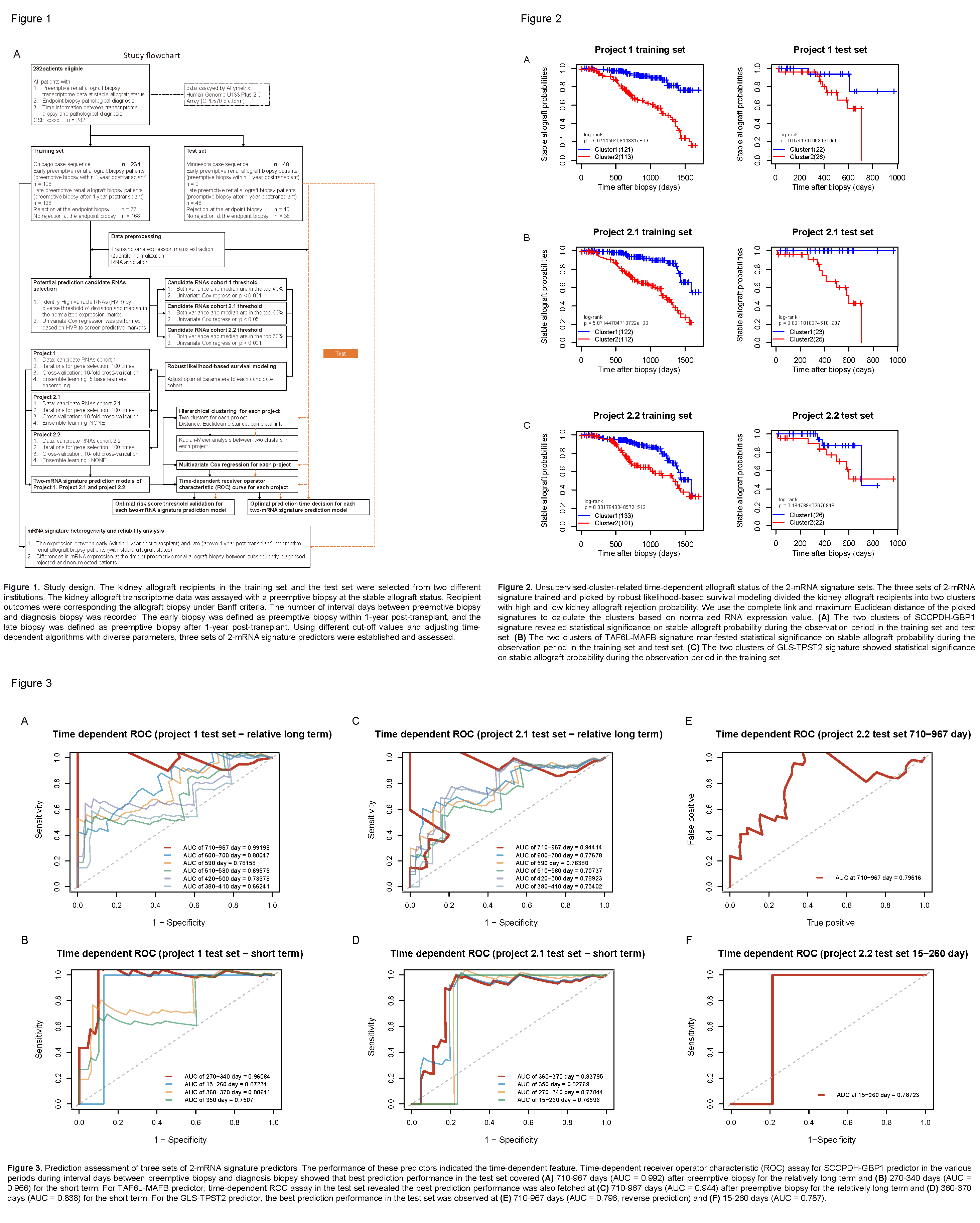The Prediction of Renal Allograft Rejection by Time-Dependent Two-Signature Predictors
1School of Medicine, University of Electronic Science and Technology of China, Chengdu, China, 2Center for Transplantation Sciences, Massachusetts General Hospital, Boston, MA, 3University of Electronic Science and Technology of China, Chengdu, China
Meeting: 2022 American Transplant Congress
Abstract number: 1541
Keywords: Biopsy, Genomic markers
Topic: Basic Science » Basic Clinical Science » 17 - Biomarkers: Clinical Outcomes
Session Information
Session Name: Biomarkers: Clinical Outcomes
Session Type: Poster Abstract
Date: Tuesday, June 7, 2022
Session Time: 7:00pm-8:00pm
 Presentation Time: 7:00pm-8:00pm
Presentation Time: 7:00pm-8:00pm
Location: Hynes Halls C & D
*Purpose: The study aims to develop RNA signature predictors using preemptive biopsy transcriptome data to predict future allograft rejection and reveal the predictors’ time-dependent features.
*Methods: Preemptive biopsy transcriptome data and clinical data were accessed from GEO. Training set and test set were recipients from two institutions. After data pre-processing and normalization, we selected candidate RNAs from the intersection of univariate cox analysis and high variable RNA (HVR, defined by high variable and median) by various thresholds. To select optimal signatures, candidate RNAs were assayed by robust likelihood-based survival modeling with 100 times iteration, 10-fold cross-validation, and an ensemble model. Hierarchical clustering was used to evaluate the relation between optimal 2-mRNA signatures and rejection probability. Following modeling predictors, we ran the time-dependent ROC assay to analyze the optimal period and threshold of the predictors. The heterogeneity and reliability of predictors were also checked.
*Results: Top 40% HVRs were enriched in T cell-mediated rejection and virus infection impacting graft survival process. The models selected three 2-mRNA signatures (SCCPDH-GBP1, TAF6L-MAFB, and GLS-TPST2). Clusters of these signatures separated the recipients with diverse rejection probabilities. The train set fully covered the interval between preemptive biopsy and diagnosis biopsy in the test set (15 – 967 days). SCCPDH-GBP1 set was selected by ensemble learning, and its risk score predictor held the best prediction capacity during days 270-340 (AUC = 0.97) and days 710-967 (AUC = 0.99) after preemptive biopsy. TAF6L-MAFB predictor manifested desirable prediction ability in days 360-370 (AUC = 0.84) and days 710-967 (AUC = 0.94). GLS-TPST2 demonstrated good prediction power during days 15-260 (AUC = 0.79) and days 710-967 (AUC = 0.80). In the test set, the optimal prediction thresholds proved a low false-negative rate (0-10%), and the risk score of predictors positively correlated with the rejection. The signature expressions showed statistical significance between rejection and no rejection in preemptive biopsy for all recipients.
*Conclusions: The mRNA signature predictors identified herein forecast future allograft rejection well. The time-dependent feature for molecular predictors may widely exist and influence the predictive performance. Further study of this feature may improve the power of molecular prediction models.
To cite this abstract in AMA style:
Liao M, Fu Q, Wei L, Yang H, Zhao G, Deng S, Markmann JF. The Prediction of Renal Allograft Rejection by Time-Dependent Two-Signature Predictors [abstract]. Am J Transplant. 2022; 22 (suppl 3). https://atcmeetingabstracts.com/abstract/the-prediction-of-renal-allograft-rejection-by-time-dependent-two-signature-predictors/. Accessed December 13, 2025.« Back to 2022 American Transplant Congress

